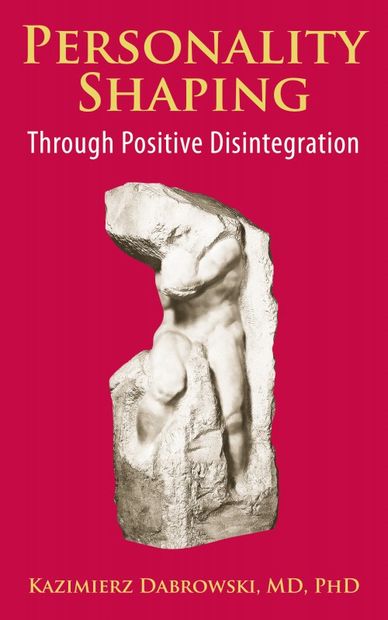Dabrowski's theory is richly layered and not easy to unpack, and I learn something new with each revisitation. This post is the first in a series about the Theory of Positive Disintegration (hereafter TPD), my current in-progress understanding of it, and why the theory is particularly useful today.
Dabrowski's 1967 book, Personality-Shaping Through Positive Disintegration, has been recently published in a new edition by Red Pill Press. The book is more accessible to a general reader than many of his other writings, and for this reason and because it is easily available as both a paperback and an ebook, I will use Personality-Shaping as the basis for this blog series in case anyone wants to follow along by reading the book (all quotations from Dabrowski otherwise unattributed will be from this new 2015 edition).
Sidetracked by Developmental Potential
"[T]here are people, not few in number, in whom, besides the schematically described cycle of life, there arises a sort of 'sidetrack,' which after some time may become the 'main track.'" ~ Kazimierz Dabrowski, Personality-Shaping Through Positive DisintegrationThe "sidetrack" in the above quotation is the path of personal development, the drive to diverge from the road laid out before us by biology and society, and the creating of ourselves anew, into the person we know we should be.
According to Dabrowski, we can think of a usual "cycle of life" as our being led mainly by basic instincts such as instincts of self-preservation, sexuality and reproduction, possessions, and social belonging. These instincts, however, can be transformed by what Dabrowski called the developmental instinct, which "transcends the narrow biological aims and exceeds the primitive drives in strength" and is "in opposition to the limited, common life cycle."
In other words, Dabrowskian development is one of learning not to be controlled by social and biological forces. A strong developmental instinct helps us instead to choose a life that is more in keeping with the person we want to be, rather than who we are or who we were, especially when who we should be is in conflict with more primitive instincts.
Related to the developmental instinct but different from it is developmental potential, or individual potential for personal development. Our developmental potential is expressed by excitabilities (OEs: heightened emotional, intellectual, imaginational, sensual, and psychomotor experiences), individual interests and capabilities, and a drive to autonomy known as the Third Factor. This is where the theory rubs shoulders with giftedness (more about this later).
Aye, There's the Rub
So far, so good, right? Who doesn't want to be a better person? Here's the catch: In order to move toward our personality ideal, we must first—and often—experience and eventually participate in disintegration.
Disintegration is just what it sounds like: conflict, falling apart, dissonance, discord. This falling apart can be triggered by physical changes such as puberty and menopause, personal tragedies such as death of a loved one or natural disasters, or anything that disrupts our inner life.
At lower levels of development, disintegration is unilevel, meaning we do not control or participate in it consciously. It happens to us. The conflict is mainly with the external world (including our physical selves). We deal with it as best we can without substantial self-evaluation or change, and we move on. An example would be disintegration that occurs because of the death of someone close to us, and after the period of grief and disintegration, the person's inner life returns more or less to where he or she was before in terms of personality.
A higher level of disintegration is multilevel disintegration, which can lead to "fundamental changes" in one's inner life. It may start with unilevel disintegration, but lasts longer, involves the whole individual and retrospection, and is experienced as conflict with ourselves rather than with the outside world. The main difference is that we are aware of a hierarchy of responses and values within ourselves. To use Dabrowski's terms, the disintegration is vertical rather than horizontal. A loved one dies, and at some point in the period of grief, we begin to question our own life, whether we are living as we should live, potentially leading to becoming different from who we were before.
An even higher level of multilevel disintegration occurs when we engage actively in the process. We lean in to the disintegration rather than try to run from or mask it, and look for opportunities to move closer to our ideal self. Our disintegration is self-directed.
On either end of this long journey of disintegration are levels of integration, when we are more or less unified with ourselves and our environment. The difference is that in the first level, we are unified because we are content to be guided by impulses and society, while in the fifth level, psychological integration is the result of a usually long and difficult "loosening" and reordering of our previous inner life. While many people live most of their lives at level one, even happily so, few people advance to the unification of level five.
The Third Factor
A crucial part of TPD and developmental potential, the "Third Factor" acts as our internal GPS by approving or disapproving of impulses and choices, measuring them against our personality ideal. Dabrowski likens the Third Factor to an active conscience. He writes that it tends to be more active during adolescence (the age of maturation) and mid-life. During the interim period, we are often busy with drives that involve starting a family, getting recognition in our job or social setting, having possessions—in other words, more or less going along with societal or familial expectations and pressures.
For those with a strong developmental potential, however, the normal course of life is different. The internal conflict inherent in adolescence, rather than resolved early as one might predict, can instead be prolonged and heightened, "with all its positive and some negative aspects":
"One may add, here, that this extension of the period of maturation is clearly connected with the developmental instinct, with greater creative abilities, with the tendencies to perfect oneself, with the advent and development of the tendencies that point to the most profound self-awareness, self-affirmation, and self-education."This extended period of growing up or "permanently maturing" has some neurobiological support. Brain imaging has suggested that brain development in children of above average intelligence begins and ends later than that of children with more average intelligence. Dabrowski's theory goes a step further to suggest that, for some people, the conflict and inner growth of adolescent may extend well into the adult years, as disintegration continues and the Third Factor strengthens.
And this brings us to one of the most hotly debated questions about Dabrowski's theory: Is it a theory of and for gifted development?
A Sidetrack to Giftedness
One criticism of how TPD has been applied to giftedness is that the OEs have been given undue attention and taken out of context. I tend to agree, more so as I become better acquainted with Dabrowski's work, and have even been guilty of it myself. In Personality-Shaping, relatively little space is devoted to what Dabrowski called nervousness or psychic excitability (OEs). He places much greater emphasis on forms and processes of disintegration.
That's not to say that knowing more about OEs isn't helpful, especially for adults who work and live with gifted children. Too often, however, I think we stop there, as if excitabilities are ends in themselves.
In Dabrowski's theory, OEs are a necessary but not sufficient component of developmental potential. Excessive excitability is a clue that a child may have the potential for inner development, showing "traits such as animism, magical thinking, an unwarranted flightiness of attention and difficulties in concentration, emotionalism, and capriciousness."
Children with OEs require support and understanding. However, developmental potential also consists of interests and talents and the Third Factor, as well as other dynamisms such as anxiety over oneself, dissatisfaction with oneself, feelings of shame and guilt, feeling of inferiority in relation toward oneself, subject-object in oneself, and the disposing and directing center (subjects for future posts). In addition, Dabrowski did not view all five OEs as having equal importance in positive disintegration, with affectional (emotional) and imaginational excitabilities serving as particular aids or conditions in personality development.
Do gifted individuals have more OEs than the general population? It depends on whom you ask. Dabrowski's research of children with superior abilities in either intellectual giftedness or specific talents found that "[e]very one of the children investigated showed considerable psychomotor, sensual, affectional [emotional], intellectual mental over excitability" (quoted in Mendaglio and Tillier).
Sharon Lind, however, wrote, "It is important to emphasize that not all gifted or highly gifted individuals have over excitabilities. However we do find more people with OEs in the gifted population than in the average population." A recent and much-discussed dissertation by Daniel Winkler looked at past studies and discovered "the relationship between giftedness and the five OEs is far more complicated and uncertain than is commonly believed," with "little to no evidence" for higher psychomotor or sensual OEs in the gifted population, "some evidence" for higher emotional and imaginational OEs, and more evidence for greater intellectual OE.
Personally, I welcome more research in this area and don't find it a problem that OEs on the whole may not be as strongly correlated with giftedness as I once thought. We can perhaps think of the gifted population and those with high developmental potential as two circles of a Venn diagram—for those in the intersecting middle, however large or small it may be, it is easy to confuse one for the other, but there is more to the big picture.
Dabrowski's theory, after all, was not about OEs, as William Tillier reminds us:
"[W]hen discussing individuals with 'superior abilities and talents,' Dabrowski's main concern and focus was on the overall developmental process (not simply overexcitability) in this group and on how we as a culture and specifically as educators can help improve our understanding and attitudes about psychoneurotic phenomena and thus reduce the persecution and alienation of this group."When gifted children do exhibit OEs and other Dabrowskian developmental clues, we can perhaps think of developmental potential as a sidetrack to their intellectual giftedness rather than equal to it, a sidetrack that may, in time and of their own choosing, become the main track.
More To Come!
Every Sunday for the rest of 2015 I will be adding posts to this series. Please share your thoughts in the comments and let me know what topics and questions you would like to see addressed here.
What do you want to know about or what is your experience with Dabrowski's Theory of Positive Disintegration?





It’s War! Real Women vs. Dudes in Skirts